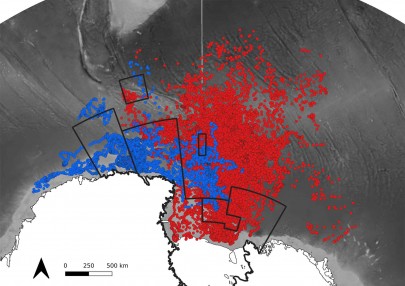Manaaki Whenua researcher Dr Dean Anderson says Adélie are a sentinel species because changes in their behaviour or population dynamics are indicative of changes in climate (which can be seen in the ice) or fishery management. Much of the Ross Sea was designated as a Marine Protected Area (MPA) in 2017, and Adélies use the entirety of the Ross Sea and the MPA through movement and migration. “If we want to be able to disentangle the effects of climate change or fisheries on their population or behaviours, we need to understand those relationships.”
Adélie penguins are the most widespread birds in the Antarctic. They breed on outcrops of Antarctic rock. At Cape Bird, where Dean and his team do their research, about 80,000 birds return every year to nest and breed, from around the start of summer in late October.

Over-winter migration location points of 53 penguins from Cape Bird, Ross Island (red) and 14 from Cape Adare, northwest Ross Sea (blue). Data were collected with light-measuring geolocators.
During the Antarctic summer Dean and the team attach GPS telemetry units to the backs of breeding adult penguins. The data show how far and where the birds are travelling to feed relative to ice and prey abundance. The birds then return to the colony to feed their chicks. Abundant ice and prey lead to efficient foraging and fast-growing chicks.
Following the breeding season, adult penguins and newly fledged chicks migrate north over a period of about 8 months. They can’t stay at the colony over winter because it is dark 24 hours a day and the sea is frozen solid. During this period, the penguins need to fatten up and gain strength to prepare for the following breeding season. To do this they need to find ‘primo Adélie luxury spots’, where they have access to water, high prey abundance, ice, and daylight (they need to see to forage). This can require a round trip of 14,000 km.
To learn where the penguins migrate, Dean and the team deploy small light-reading devices on the ankles of breeding adults. The information gained provides an understanding on how climate change and fisheries may impact survival and behaviour during this critical time.
The work is about establishing a relationship between the migration patterns, ice conditions, prey abundance, and sea currents, so that when change does happen it makes it possible to attribute the change to something in particular, for instance either climate change or changes in fishery practices.
The next steps in the project are to start using remote sensing to start monitoring the size of penguin breeding colonies across the Ross Sea.
“If we can use satellite images to count every year then we can really monitor the annual fluctuations and relate that to changes in the larger Ross Sea,” says Dean. While the satellites can’t yet distinguish individual penguins, they do show up differences in the pink-coloured guano on top of grey-black rock. “We can establish a relationship between how much area is covered in guano and the number of penguins,” says Dean.
Those data feed into a model that can show whether population changes are natural fluctuations or due to deviations in sea ice or prey abundance, which would be indicative of the effects of climate change or fisheries management.
Dean says 3 years of data so far have given a good baseline of relationships between ice conditions and fisheries practices. “The Ross Sea is in a marine protected environment, but it’s only set in place for 35 years. We really need a scientific basis for making decisions on what happens to it after that.”
